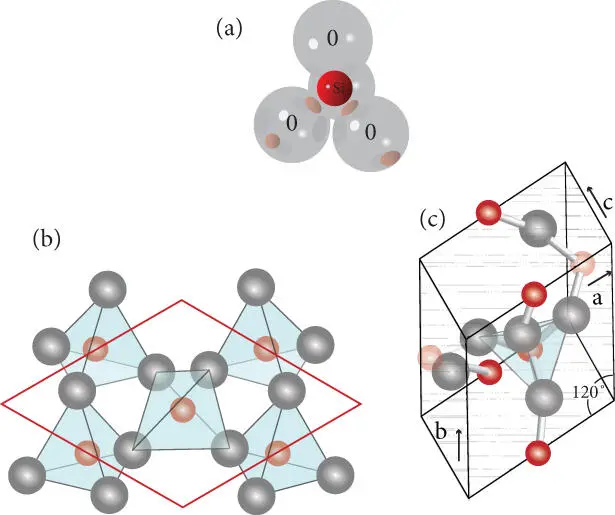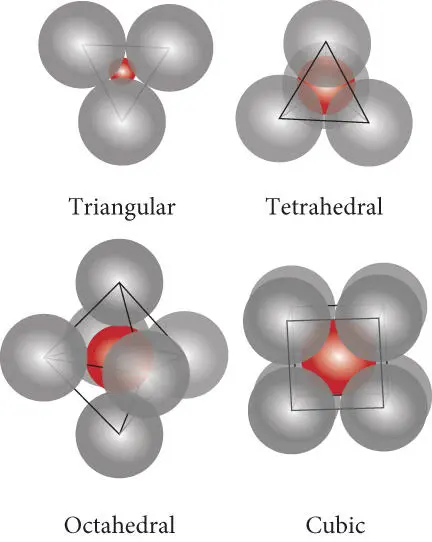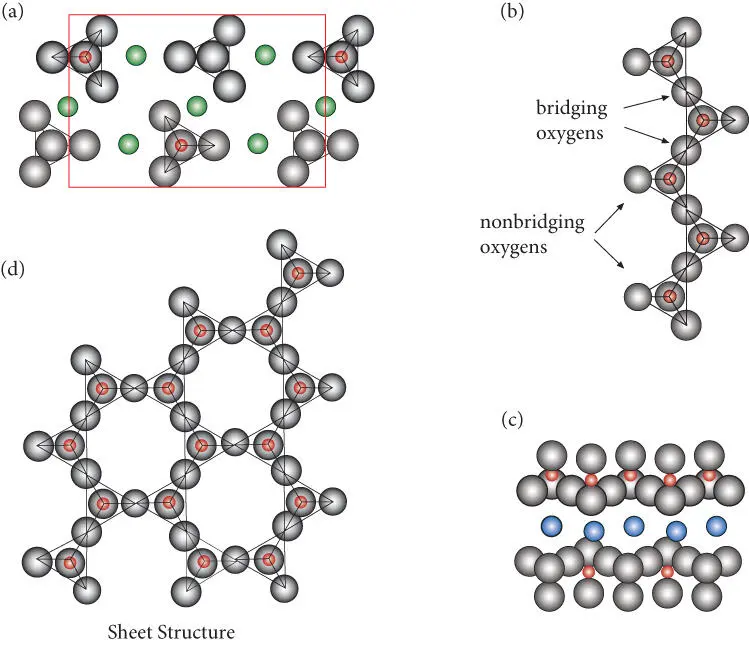How do we go from  to the chemical formula of SiO 2? Each oxygen atom shared by two silicon atoms; that is, each is part of two tetrahedra. These linked tetrahedra are repeated infinitely to produce a quartz crystal ( Figure 1.9b). We can define a unit cell that contains all the necessary information to describe both the chemical and structural elements of quartz ( Figure 1.9c). The unit cell of lattice is defined by the length of three axes and the angles between them. In the case of quartz, the lattice cell has the chemical formula of Si 3O 6and axes of lengths: a = 0.49 nm, b = 0.49 nm, and c = 0.54 nm, with the b – c and b – a angles are equal to 90° and the angle between the a and c axes equal to 120°. The quartz crystal is built up by repetition of the unit cell along its principal axes.
to the chemical formula of SiO 2? Each oxygen atom shared by two silicon atoms; that is, each is part of two tetrahedra. These linked tetrahedra are repeated infinitely to produce a quartz crystal ( Figure 1.9b). We can define a unit cell that contains all the necessary information to describe both the chemical and structural elements of quartz ( Figure 1.9c). The unit cell of lattice is defined by the length of three axes and the angles between them. In the case of quartz, the lattice cell has the chemical formula of Si 3O 6and axes of lengths: a = 0.49 nm, b = 0.49 nm, and c = 0.54 nm, with the b – c and b – a angles are equal to 90° and the angle between the a and c axes equal to 120°. The quartz crystal is built up by repetition of the unit cell along its principal axes.

Figure 1.9 (a) The silica tetrahedron,  , consists of a silicon atom surrounded by four oxygens. This is the basic building block of silicate minerals. (b) In quartz, each oxygen (gray) is shared between two tetrahedra to produce a three-dimensional structure. (c) The quartz unit cell consists of a central Si atom whole within the cell and with four Si atoms on the edges that are shared by adjacent unit cells, hence it contains 1 + 4 × ½ Si = 3 Si (faded silicon atoms are outside the cell). Six oxygens are wholly within the cell, so the chemical formula of the cell is Si 3O 6; a, b, and c are the crystallographic axes.
, consists of a silicon atom surrounded by four oxygens. This is the basic building block of silicate minerals. (b) In quartz, each oxygen (gray) is shared between two tetrahedra to produce a three-dimensional structure. (c) The quartz unit cell consists of a central Si atom whole within the cell and with four Si atoms on the edges that are shared by adjacent unit cells, hence it contains 1 + 4 × ½ Si = 3 Si (faded silicon atoms are outside the cell). Six oxygens are wholly within the cell, so the chemical formula of the cell is Si 3O 6; a, b, and c are the crystallographic axes.
Crystals have varying degrees of symmetry that can be divided into seven different systems, which, with decreasing symmetry, are cubic, hexagonal, trigonal, tetragonal, orthorhombic, monoclinic, and triclinic (sometimes trigonal is included with hexagonal to give only six systems). The cubic system has the highest symmetry, with all three axes of equal length and all three angles equal to 90°; triclinic has the lowest, with no axes of equal length and no angles of 90°. Diamond is an example of a cubic mineral. Quartz, with two equal length axes and one 120° angle, is an example of a trigonal mineral. Graphite, in its most common form, is hexagonal. Since all axes are equal in cubic crystals, they transmit light and vibrations, sound, and seismic waves, equally in all directions. Hexagonal, trigonal, and tetragonal have one unique crystallographic axis that transmits light and sound at different velocities than the other two and are said to be uniaxial. The least symmetric classes, orthorhombic, monoclinic, and triclinic as said to be biaxial and transmit light and sound at three different velocities along the three axes.
Minerals are by definition naturally occurring inorganic crystalline solids. Most minerals are “ionic solids” that consist of cations, metals or metalloids, bound to nonmetals or anionic radicals (although the bonds can have a partly covalent character; in quartz for example, bonds between the oxygens and silicon are roughly 50% covalent and quite strong). In the majority of minerals, several metals are present and only a single anion, most often oxygen. For these kinds of crystals, rules elaborated by Linus Pauling in 1929, known as Pauling's rules , dictate crystal structure. The first of these is that the ratio of cation to anion radius determines the number of anions that coordinate the cation and the shape of the coordinated polyhedron of anions. Smaller cations will be surrounded by few anions, larger cations will be coordinated by more anions ( Figure 1.10). When the cation/anion radius ratio is <0.22, three anions will coordinate each anion, forming a triangular polyhedron; when the ratio is >0.22 and <0.414, four anions coordinate the cation; the radius Si 4+is 40 pm, that of O 2–is 126 pm, so the ratio is 0.317. As a result, the four oxygens form a tetrahedron around silicon. For a ratio >0.414 and <0.73, six anions surround the cation in octahedral coordination, as in halite, which has a Na +/Cl –radius ratio is 0.56. If the ratio is ≥0.73, eight coordinating anions will form a cube. Pauling's second rule is that the electrostatic bond strength between the cation and each coordinating anion is equal to the cation charge divided by the number of coordinating anions. So highly charged, small cations are more strongly bond than large ones with smaller charge.

Figure 1.10 Geometric relationships between cations and their coordinating anions. Because they have fewer electrons relative to protons, cations tend to be small, while anions, with excess electrons, tend to be large. The number of anions that immediately surround and bond to a cation depends on the relative radii. Small cations, such as B 3+in the borate ion, are coordinated by only three oxygens, Si in quartz by four, and Na in halite by six; if Na +is replace by Cs +, a much larger ion, the coordination number increases to eight.
Another of Pauling's rules is that in a crystal containing different cations, those of high valency and small coordination number tend not to share polyhedron elements with one another. Most silicate minerals contain more than one cation; like quartz, the Si tetrahedron is the basic structural unit, but unlike quartz, not all oxygens are shared. In orthosilicates, the silica tetrahedra are either completely independent or form dimers – that is, two linked tetrahedra. A good example of a mineral of this type is olivine, whose structure is illustrated in Figure 1.11a. The chemical formula for olivine is (Mg,Fe) 2SiO 4. The notation (Mg,Fe) indicates that either magnesium or iron or both may be present. Olivine is an example of a solid solution between the Mg end-member, forsterite (Mg 2SiO 4), and the Fe end-member, fayalite (Fe 2SiO 4). Such solid solutions are quite common among silicates. As the formula indicates, there are two magnesium or iron atoms for each silica tetrahedron. Since each Mg or Fe has a charge of +2, their charge balances the −4 charge of each silica tetrahedron. Olivine constitutes roughly 50% of the Earth's upper mantle and is thus one of the most abundant minerals on Earth.
In chain silicates, the silica tetrahedra are linked together to form infinite chains ( Figure 1.11band c), with two bridging oxygen per tetrahedron. Oxygens shared by two silicons are called bridging oxygens . Minerals of this group are known as pyroxenes and have the general formula XSiO 3where X is some metal, most commonly Ca, Mg, or Fe, which is located between the chains. Two pyroxenes, orthopyroxene ((Mg,Fe)SiO 3) and clinopyroxene (Ca(Mg,Fe)Si 2O 6) are very abundant in the Earth's upper mantle as well as in mafic igneous rocks. The pyroxenes wollastonite (CaSiO 3) and jadeite (NaAlSi 2O 6) are found exclusively in metamorphic rocks.

Figure 1.11 Silicate mineral structures. (a) In orthosilicates such as olivine, the tetrahedra are separate and each oxygen is also bound to other metal ions that occupy interstitial sites between the tetrahedra. (b) In pyroxenes, the tetrahedra each share two oxygens and are bound together into chains. (c) Metal ions are located between the chains in pyroxenes. (d) In sheet silicates, such as talc, mica, and clays, the tetrahedra each share three oxygens and are bound together into sheets.
Читать дальше

 to the chemical formula of SiO 2? Each oxygen atom shared by two silicon atoms; that is, each is part of two tetrahedra. These linked tetrahedra are repeated infinitely to produce a quartz crystal ( Figure 1.9b). We can define a unit cell that contains all the necessary information to describe both the chemical and structural elements of quartz ( Figure 1.9c). The unit cell of lattice is defined by the length of three axes and the angles between them. In the case of quartz, the lattice cell has the chemical formula of Si 3O 6and axes of lengths: a = 0.49 nm, b = 0.49 nm, and c = 0.54 nm, with the b – c and b – a angles are equal to 90° and the angle between the a and c axes equal to 120°. The quartz crystal is built up by repetition of the unit cell along its principal axes.
to the chemical formula of SiO 2? Each oxygen atom shared by two silicon atoms; that is, each is part of two tetrahedra. These linked tetrahedra are repeated infinitely to produce a quartz crystal ( Figure 1.9b). We can define a unit cell that contains all the necessary information to describe both the chemical and structural elements of quartz ( Figure 1.9c). The unit cell of lattice is defined by the length of three axes and the angles between them. In the case of quartz, the lattice cell has the chemical formula of Si 3O 6and axes of lengths: a = 0.49 nm, b = 0.49 nm, and c = 0.54 nm, with the b – c and b – a angles are equal to 90° and the angle between the a and c axes equal to 120°. The quartz crystal is built up by repetition of the unit cell along its principal axes.
 , consists of a silicon atom surrounded by four oxygens. This is the basic building block of silicate minerals. (b) In quartz, each oxygen (gray) is shared between two tetrahedra to produce a three-dimensional structure. (c) The quartz unit cell consists of a central Si atom whole within the cell and with four Si atoms on the edges that are shared by adjacent unit cells, hence it contains 1 + 4 × ½ Si = 3 Si (faded silicon atoms are outside the cell). Six oxygens are wholly within the cell, so the chemical formula of the cell is Si 3O 6; a, b, and c are the crystallographic axes.
, consists of a silicon atom surrounded by four oxygens. This is the basic building block of silicate minerals. (b) In quartz, each oxygen (gray) is shared between two tetrahedra to produce a three-dimensional structure. (c) The quartz unit cell consists of a central Si atom whole within the cell and with four Si atoms on the edges that are shared by adjacent unit cells, hence it contains 1 + 4 × ½ Si = 3 Si (faded silicon atoms are outside the cell). Six oxygens are wholly within the cell, so the chemical formula of the cell is Si 3O 6; a, b, and c are the crystallographic axes.












